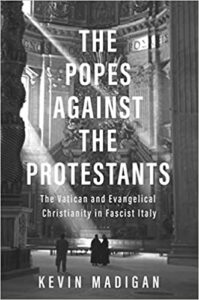Contemporary Church History Quarterly
Volume 30, Number 4 (Winter 2024)
Review of David I. Kertzer, The Pope at War. The Secret History of Pius XII, Mussolini, and Hitler (New York: Random House, 2022). ISBN: 978-0812989946.
By Martina Cucchiara, Bluffton University
With his monograph The Pope at War. The Secret History of Pius XII, Mussolini, and Hitler David I. Kertzer—who has published extensively on the Italian state and the Vatican’s relations with Jews—has added his critical voice to the longstanding controversy surrounding the papacy of Pius XII (r. 1939–1958). There is no shortage of biographers who have attempted to understand the pope’s (in)actions during World War II and the Holocaust, but according to Kertzer, “a crucial piece of the puzzle has long been missing,” because the Vatican has only recently (in March 2020, to be exact) unsealed the archive of Pius XII’s papacy (p. xxix). Making extensive use of this and numerous other European collections, Kertzer writes that “The Pope at War offers readers the first full account of these events” (p. xxx). What follows is an unsparing and detailed narrative of Pope Pius XII’s moral failure in Europe’s darkest hour.

Version 1.0.0
The monograph opens—somewhat unusually, and reminiscent of a play—with a “Cast of Characters” that offers brief biographies of key figures in this history. Even at this early stage, Kertzer is blunt in his assessment of many members of the Curia as unprepared for and unequal to the momentous tasks before them. Divided into four parts, the book begins with the final months of the dying Pius XI’s papacy when, for a brief moment, it appeared that the Vatican might issue a condemnation of Fascism and Nazism. The encyclical died along with Pius XI on 10 February 1939; the ascendence of the Vatican’s Secretary of State, Eugenio Pacelli, to the papacy followed on 2 March 1939. The seasoned diplomat Pacelli, now Pope Pius XII, immediately shifted to a conciliatory approach toward Germany and Italy when “he instructed the Vatican newspaper, L’Osservatore Romano, to end all criticism of the German government” (p. 27).
The new pope’s first major test of his moral leadership came only two days after his coronation, on 14 March 1939, when Germany invaded Czechoslovakia. Immediately, the new pontiff faced considerable pressure to denounce the German invasion but, setting the tone for his wartime papacy, Pius XII remained silent (p. 33). Kertzer makes clear that Pius XII did not remain silent because he was “Hitler’s Pope,” as John Cornwell’s 1999 monograph by the same name claimed. The pontiff had nothing but disdain for Hitler and the Nazis, and in his dealings with them, his first priority was the protection of the institutional Catholic Church in Germany. This is not a new argument. What Kertzer adds is new evidence of secret negotiations between Pius XII and Hitler, in which Prince Philipp von Hessen represented the latter. The prince was both a very close friend of Hitler and the son-in-law of Italy’s King Victor Emmanual. The two men met for the first time on 11 May 1939 to discuss ways for improving the situation of the Catholic Church in Nazi Germany. Eager to reach an agreement, the pope assured the prince, “‘The German people are united in their love for their Fatherland. Once we have peace, the Catholics will be loyal, more than anyone else’” (p. 62). In this and subsequent meetings, von Hessen dangled the possibility of a rapprochement between the Vatican and Germany before the pope. Nothing came of it, of course, and the situation of the Church in Germany continued to deteriorate. The pope nonetheless clung to his conciliatory approach and refused to criticize either Nazi Germany or Fascist Italy, even in the face of the extreme violence of World War II and the brutal persecution and mass murder of Jews in the Holocaust.
Kertzer relentlessly makes the argument of the moral bankruptcy of the pope’s leadership in example after example of his refusal to speak out. As the Germans rampaged through Catholic Poland, perpetrating unspeakable crimes against civilians, including members of the clergy, Pius XII remained silent. This silence cannot be explained by a lack of accurate intelligence. At no time did the Vatican lack detailed information about German atrocities, including the genocide against Jews. Defenders of Pius XII have argued that it is anachronistic and thus impossible to judge him by the standards of our time in which the defense of universal human rights is paramount. This, they argue, was not the case in 1940, when the Church’s salvific mission dictated that the pope had to do everything in his power to protect the faithful’s access to the sacraments. Kertzer rejects this argument. He shows that the controversy over of the pope’s timidity and silence during the war and genocide did not commence in the postwar period. Rather, as early as the fall of 1939, after the Polish ambassador had appealed in vain to Pius XII to speak out against German atrocities in Poland, the British envoy to the Vatican, Richard Osborne, lamented that the pontiff “has carried caution and impartiality to a point approaching pusillanimity and condonation…the Pope’s silence seems hard to explain and defend” (p. 88). The Allied ambassadors and envoys to the Vatican would repeat this statement in their reports in many different reiterations and with increasing exacerbation for the duration of the war. Pius XII also was pressured to speak out against Germany from members of his own curia, including the French cardinal Eugène Tisserant, who complained to the archbishop of Paris in 1940 that “I fear that history will have much to reproach the Holy See for in having adopted a policy of convenience for itself and not much more… It is sad in the extreme, above all when one has lived under Pius XI” (p. 90). Kertzer makes the case that the pope’s silence was not the expected or acceptable conduct of a pontiff at the time but was instead driven by his personality in direct opposition to many who beseeched him to act differently and courageously.
By 1942, the pressure on the pope to speak out became enormous. In his twenty-four-page Christmas message that year, he finally decried the death of “’hundreds of thousands of [innocent] people… solely because of their nation or their race’” (p. 258). Although this speech is often cited as proof of Pius XII’s vocal protest against genocide, Kertzer dismisses this assertion. Rather, he concludes that the speech was in line with his previous convoluted, cautious, and ambiguous statements, all of which accomplished little. The following year, the German occupation of Rome in September 1943 and the subsequent round-up of Roman Jews put the pope’s “policy of not criticizing the Nazis’ ongoing extermination of Europe’s Jews to an excruciating test” (p. 363). Kertzer argues that the Vatican made only feeble attempts to intervene diplomatically to aid Catholics of Jewish heritage, but even those interventions often came too late. Pius XII’s action on behalf of Rome’s Jews have been the focus of much research, including research on the rescue and hiding of Jews in Catholic convents, and here and throughout the monograph, The Pope at War could have benefitted from a deeper engagement with the extant historiography on the topic.
Attempting to explain the pope’s appeasement of Germany and Italy, Kertzer argues that, prior to 1942, when it appeared that the Axis powers were winning the war, he sought ways for the Church to function within this new reality. The seat of the Holy See was, after all, in Rome and at the heart of Fascism. Whereas Kertzer does a good job describing the fraught history between the Vatican and Nazi Germany, this is not the book’s main strength. The Pope at War is as much the story of Mussolini as it is of Pope Pius XII. Kertzer shows his deep expertise and knowledge of the papacy and Fascist Italy and excels in rendering—often in excruciating detail—the intertwined stories of the vainglorious, pompous dictator and the timid, ascetic pontiff who used, disdained, and resented each other in equal measure. In writing this detailed history of the collaboration between the Italian Fascist government and the Vatican, Kertzer seeks to correct a postwar history of Fascist Italy and the papacy which, he argues, all too quickly forgot their close collaboration with each other—and with Germany. In this history, “All the efforts the pope made to avoid antagonizing Hitler and Mussolini are wiped from view. His role as primate of the Italian church, presiding over a clergy that was actively supporting the Axis war, is likewise forgotten” (p. 464). This is an overstatement, as there already exists a robust and critical historiography on the subject, but The Pope at War no doubt enriches the scholarship on Fascist Italy and adds ample fuel to the ongoing controversy surrounding Pius XII’s papacy.

 The main source material that Madigan draws upon comes from the pontificate of Pius XI (1922-1939), the records of which only became available in 2006. But the story begins in the Risorgimento in the mid-nineteenth century and the triumph of a new liberal order that brought religious tolerance in the form of openness to non-Catholic religious confessions. Into this environment emerged evangelical Protestant missionaries from England and America, many of whom were Italian immigrants who had converted to a form of Protestantism in their new country and later returned to Italy. Methodists, Baptists, Pentecostals, the Salvation Army, the YMCA, Jehovah’s Witnesses, and Adventists brought with them an evangelical style of preaching that emphasized conversion and an array of educational, medical, and social programs that benefited the Italian lower classes and peasantry. The fact that this Protestant missionary activity mapped onto a global trend of Protestant expansion in this period was all the more concerning for the Vatican, especially after World War I and the growth of Anglo-American power.
The main source material that Madigan draws upon comes from the pontificate of Pius XI (1922-1939), the records of which only became available in 2006. But the story begins in the Risorgimento in the mid-nineteenth century and the triumph of a new liberal order that brought religious tolerance in the form of openness to non-Catholic religious confessions. Into this environment emerged evangelical Protestant missionaries from England and America, many of whom were Italian immigrants who had converted to a form of Protestantism in their new country and later returned to Italy. Methodists, Baptists, Pentecostals, the Salvation Army, the YMCA, Jehovah’s Witnesses, and Adventists brought with them an evangelical style of preaching that emphasized conversion and an array of educational, medical, and social programs that benefited the Italian lower classes and peasantry. The fact that this Protestant missionary activity mapped onto a global trend of Protestant expansion in this period was all the more concerning for the Vatican, especially after World War I and the growth of Anglo-American power.